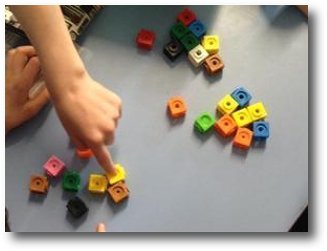This teacher assessment framework has limited support to help teachers make judgements and does not help with any formative or summative assessment strategies or how to gather evidence. It states that 'teachers must base their teacher assessment judgement on a broad range of evidence from across the curriculum for each pupil.'
So, what does this involve?
1. Know the maths you are teaching. Read around the topic and have a real understanding of the pitfalls, the areas that will need careful modelling, the common misconceptions and the small prior steps that are pre-requisites to the learning. You will then have a good feel for the depth of understanding when asking questions, observing and talking to the children.
2. Know the children you are teaching. They each have different ways of learning and need varying amounts of reassurance, confidence boosts and 'self-esteem-raising', before they get to grips with the actual process of making sense of the maths they are learning. You can then make informed judgements based on their confidence as well as their understanding.
3. Encourage active learning. Based on the learning theory of constructivism, the learner constructs meaning for themselves rather than as a passive recipient. Your role is to coach and scaffold through language or action, but, most importantly, it gives you the opportunity to watch and listen to the children as they make sense of the maths and reflect on their learning.
5. Have very clear learning objectives and expected outcomes. Share these with the children so they know what they are aiming for and so they can be involved in their own assessment. As Jo Boaler puts it, "students should have a full and clear sense of what they are learning, of where they are in the path towards mastery, and what they have to do to become successful.” It then makes it much easier to make a judgement of the depth of understanding related to success criteria based on the expected outcomes.
6. Give opportunities for children to reason and solve problems. Plan for a range of activities that involve children in applying the skills, concepts and procedures they have learnt. Cross-curricular links, problems, challenges, puzzles and games all give opportunities for you to observe, listen and talk to the children about the depth of their understanding and their confidence with newly learnt skills or strategies.Here are the main headlines from the DfE pages for the Key Stage 1 and Key Stage 2 interim frameworks:
- There is no longer a ‘best-fit’ judgement - pupils need to meet all of the statements within that standard;
- it is only used to make a teacher assessment judgement at the end of the key stage following the completion of the key stage 1 or 2 curriculum;
- it is not intended to be used to track progress throughout the key stage;
- it does not include full coverage of the content of the national curriculum - focuses on key aspects for assessment;
- pupils achieving the standard will be able to demonstrate a broader range of skills than those being assessed;
- it is not intended to guide individual programmes of study, classroom practice or methodology;
- teachers must base their teacher assessment judgement on a broad range of evidence;
- individual pieces of work should be assessed according to a school’s assessment policy.
Each of the three standards within the interim framework contains a number of ‘pupil can’ statements.
To demonstrate that they have met the standard, teachers will need to have evidence that a pupil demonstrates consistent attainment of all of the statements within that standard and, for KS1, all the statements in the preceding standard(s).
This framework is for the academic year
2015 to 2016 only.
How are you assessing the progress of your children?
Assessing is a key part of the planning-teaching-assessing- reviewing cycle
Assessment without levels
Tim Oates give a clear message on the expectations for assessment in schools



